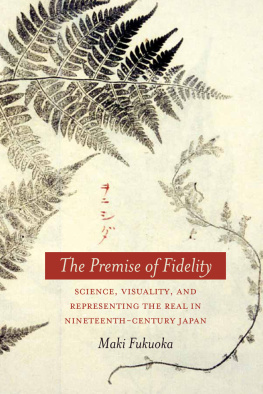The Premise of Fidelity
SCIENCE, VISUALITY, AND REPRESENTING THE REAL IN NINETEENTH-CENTURY JAPAN
Maki Fukuoka
STANFORD UNIVERSITY PRESS
STANFORD, CALIFORNIA
Stanford University Press
Stanford, California
2012 by the Board of Trustees of the Leland Stanford Junior University.
All rights reserved.
Receipt of an Association for Asian Studies First Book Subvention has facilitated the publication of this book.
No part of this book may be reproduced or transmitted in any form or by any means, electronic or mechanical, including photocopying and recording, or in any information storage or retrieval system without the prior written permission of Stanford University Press.
Printed in the United States of America on acid-free, archival-quality paper
Library of Congress Cataloging-in-Publication Data
Fukuoka, Maki, 1972- author.
The premise of fidelity : science, visuality, and representing the real in nineteenth-century Japan / Maki Fukuoka.
pages cm
Includes bibliographical references and index.
ISBN 978-0-8047-7790-2 (cloth : alk. paper)
ISBN 978-0-8047-8462-7 (ebook)
1. Art and scienceJapanHistory19th century. 2. Botanical illustrationJapanHistory19th century. 3. Plant printsJapanHistory19th century. 4. PhotographyJapan-History19th century. 5. Realism in artJapanHistory19th century. I. Title.
N72.S3F85 2012
709.52dc23
2012007601
Typeset by Bruce Lundquist in 11/14 Adobe Garamond
Contents
List of Figures
Acknowledgments
It would be an understatement to say that this project came easily. It would be even more inaccurate to characterize this project as my solo endeavor. The generosity and support of institutions, colleagues, friends, and family members have been instrumental to this publication.
Since the genesis moment in a graduate seminar on the intellectual history of modern Japan in the fall of 1999, Professor Tetsuo Najitas insight and criticism helped tremendously in modeling this project. In the Department of Art History at the University of Chicago, where I completed my graduate work, Professors Tom Gunning and Joel Snyder advised me with care and skill to steer my ideas from a (sometimes useful) misguided direction back to an appropriate path. Toms generosity in sharing his knowledge and ideas of modernity continue to shape my interest and research. Working with Joel has opened many closed doors of inquiry about photography and representations and guided me into unexplored territories. Professor Susan Burns stepped into this project at the final stage of dissertation, and her suggestions brought into light a constructive perspective on the broader historical landscape that became essential in revision.
In Tokyo, Professor Kinoshita Naoyuki at the University of Tokyo kindly accepted me to his kenkyshitsu in November 2001. His eye for objects and history, and his uncanny way of navigating the strange continue to mesmerize and inspire me. Kinoshita-senseis humor gave me a profound sense of comfort that lasts to this day.
Since my first archival research trip to Nagoya in 2001, Endo Shji has been more than generous in sharing his collection and knowledge of materials related to the Shhyaku-sha. I only hope that I did some justice to the wealth of the Shhyaku-sha material. Also in Nagoya, Yokoyama Susumu of the Higashiyama Botanical Garden welcomed me with great kindness during my repeated visits to the archives. In Tokyo, Sato Mona of the University of Tokyo gracefully helped me relearn classical Chinese and Japanese, and her willingness to decipher cultural connotations was indispensable in many of the close readings of the primary text. In Leiden, Professor Matthi Forrers initial encouragement convinced me to take the first step in this endeavor. Since 2006, Christine Guth, Katsuya Hirano, William Schaefer, and Timon Screech have given me invaluable comments and suggestions on versions of the manuscript drafts.
This project was supported by several generous fellowships. The initial dissertation research in the Netherlands was supported by a Lipman travel grant and a Smart Foundation travel grant, both from the Department of Art History at the University of Chicago. The archival research in Japan in 200102 was made possible through a Japan Foundation Dissertation Fellowship. A dissertation write-up grant from the Center for East Asian Studies at the University of Chicago in 200304 and a Whiting Fellowship from the Division of Humanities at the University of Chicago between 2004 and 2005 provided me with the critical financial support to continue and finish my dissertation. For post-dissertation revisions, a Faculty Research Grant from the Center for Japanese Studies at the University of Michigan allowed me to examine objects in the UK that had otherwise been difficult to inspect. In 200809, a Robert and Lisa Sainsbury Fellowship from the Sainsbury Institute for the Studies of Japanese Arts and Cultures offered me a tremendous opportunity and time to concentrate on revising the manuscript.
The collegial support of the Department of Asian Languages and Cultures at the University of Michigan has been instrumental, and I am particularly thankful for the support of Micah Auerbach, Ben Brose, Deirdre de la Cruz, Ken Ito, Christi Merrill, Youngju Ryu, and Jonathan Zwicker. Nancy Florida and Donald Lopez, the chairs of the department, have offered me realistic and experienced guidance since my arrival in Ann Arbor. In the larger community of the University of Michigan, Kevin Carr, Joan Kee, Christian de Pee, Leslie Pincus, and Sarita See have been there when I needed a sounding board. For its financial support of this publication, I am grateful to the Faculty Grants and Awards Program of the University of Michigans Office of the Vice President for Research. Kerry Boeye and Jenn Wright kindly copyedited my draft with such grace and intellect, and I am indebted to their refined editing skill and friendship. The support of Stacy Wagner and Jessica Walsh, editor and editorial assistant at Stanford University Press, has proven vital in the last phase of this project.
Many family members and close friends who shall remain unnamed in Japan, the Netherlands, the UK, and the United States made writing this book easier through their extraordinary friendship and compassion. Their companionship and willingness to engage in dialogue was critical to navigating, both literally and metaphorically, the webs of life that presented themselves, unexpectedly and delightfully. You know who you are. I am profoundly indebted to my parents, Fukuoka Kanefusa and Yamaguchi Hiroko, who first instilled in me the pleasures of traveling to unknown cities and museums and seeing the world with my own eyes.
Despite all of the generous and constructive advice I have received, all errors in this book are entirely my own.
Note on Names
Japanese names in this book follow the Japanese order with family name followed by given or literary name. It is standard practice in the study of Tokugawa Japan to refer to historical figures by their given or literary name rather than surname. As a result, I have adopted this convention in this book. For the sake of consistency, I also use the given or literary name to refer to historical figures of modern Japan, though use of surname would otherwise be the convention.
Introduction
An unpublished manuscript entitled Honz sjasin, compiled in 1826 by the scholar Mizutani Hbun, first revealed to me that a vital part of the history of nineteenth-century Japanese visual culture had yet to be written. The term shashin, I discovered later, would be the keyword to apprehend the interconnected fields of visual culture and scientific studies in Tokugawa Japan. The manuscript resides today at the Special Collection of Leiden University Library as part of the collection of books and maps amassed by Phillip Franz von Siebold, a German physician who worked in Japan at the Dutch factory from 1823 to 1829. I had initially traveled to Leiden in search of a Japanese zograscope, a viewing device for
Next page








